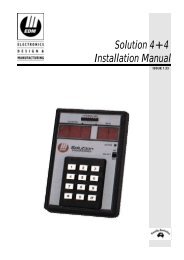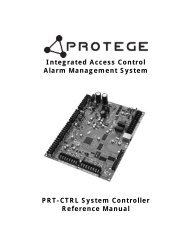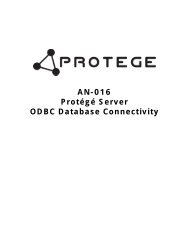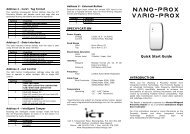SecureStream IP Receiver - Security Help Desk
SecureStream IP Receiver - Security Help Desk
SecureStream IP Receiver - Security Help Desk
Create successful ePaper yourself
Turn your PDF publications into a flip-book with our unique Google optimized e-Paper software.
Step<br />
Instructions<br />
3 At this stage you can either:<br />
• use the default encryption key already set up in the Configuration Editor. Click Load<br />
With Default Key.<br />
• enter an individual encryption key for the panel. The number range for each field is<br />
0-255. Select the numbers by either clicking the up or down arrows until the correct<br />
number displays or type the number with the keyboard.<br />
T<strong>IP</strong>: Ignore the upload and download buttons.<br />
4 Click the Save icon to save the changes.<br />
Tips on encryption<br />
<strong>IP</strong> Timeouts tab<br />
The one special case to consider is when all bytes of the encryption key are set to 0 — this disables<br />
encryption. In this state data exchanged with the panel is unencrypted and is observable by<br />
anybody with commonly available network monitoring tools.<br />
If an encryption error occurs (i.e., messages from the panel cannot be processed successfully),<br />
<strong>SecureStream</strong> <strong>IP</strong> will send an error message to the monitoring computer. The exact message sent is<br />
set in the configuration editor (see Working with the Warning Events tab on page 19).<br />
The <strong>IP</strong> Timeouts tab sets the event acknowledgement and heartbeat for individual panels.<br />
Event Acknowledgement: Challenger expects an acknowledgment for every event it sends to<br />
<strong>SecureStream</strong> <strong>IP</strong>. The Event Acknowledgement is the maximum number of seconds Challenger waits<br />
before trying to send the event again. Challenger tries three times before assuming the<br />
<strong>SecureStream</strong> <strong>IP</strong> <strong>Receiver</strong> is offline.<br />
Heartbeat: The maximum time Challenger waits for a poll from <strong>SecureStream</strong> <strong>IP</strong> before assuming<br />
the <strong>SecureStream</strong> <strong>IP</strong> <strong>Receiver</strong> is offline. If the heartbeat fails, Challenger sends an event to the<br />
monitoring station to tell it the <strong>SecureStream</strong> <strong>IP</strong> <strong>Receiver</strong> is offline. Challenger also regularly checks if<br />
<strong>SecureStream</strong> <strong>IP</strong> <strong>Receiver</strong> is back online again.<br />
Figure 22: Editing a Challenger panel’s Ethernet parcel, <strong>IP</strong> Timeouts tab<br />
36 <strong>SecureStream</strong> <strong>IP</strong> <strong>Receiver</strong> Installation & Programming Guide 2.0
















